By: Stephen Day(Author), John Parker(Author), Steve Rose(Author)
192 pages, 150 colour photos, colour illustrations, includes CD-ROM
![The Sainsbury Laboratory The Sainsbury Laboratory]()
Click to have a closer look
About this book
Customer reviews
Related titles
About this book
The new Sainsbury Laboratory in Cambridge's Botanic Garden, opened in late 2011, will be the leading international centre for the study of plant science, and enabled by the bequest of the Sainsbury family. The Sainsbury Laboratory is divided into three sections; "science," "architecture" and "art." The "science" refers to the scientific practice of the laboratory, the "architecture" to the cutting-edge building and the "art" to the profiled artists who are involved in the project.
The Sainsbury Laboratory provides a brief history of plant science, with Darwinist theory setting the context for the centre and today's research. The Botanic Garden first opened in Cambridge in 1762. It was shortly after this that Professor John Stevens Henslow first undertook his studies into plants, and planted trees to use as teaching aids; amongst his students was Charles Darwin. Henslow's teachings in Cambridge are thought to be the inspiration by which Darwin set out his own thinking.
Both Henslow's and Darwin's plant specimens are housed in the Herbarium at the laboratory, which holds a collection of over one million plant specimens from all over the world and from throughout thehistory of scientific plant study. The Sainsbury Laboratory discusses the architecture of the Sainsbury Laboratory designed and built by Stanton Williams Architects, with sketches and photographs of the building from conception to completion. The "Art" section of the book includes interviews with the three artists specially commissioned to provide installations at the Laboratory – Norman Ackroyd, Susanna Heron and William Pye.
The book's sections are written by different experts in the field and include a Foreword by Lord David Sainsbury and interviews with American plant scientist Elliott Meyerowitz, laboratory specialists and the architects involved in the project. Beautifully illustrated, The Sainsbury Laboratory provides an in-depth look at the important fields of plant science, public art and architecture.
Customer Reviews
By: Stephen Day(Author), John Parker(Author), Steve Rose(Author)
192 pages, 150 colour photos, colour illustrations, includes CD-ROM
























